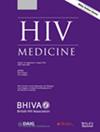A programmatic assessment of dolutegravir adverse events and discontinuations in Uganda
Abstract
Introduction
Dolutegravir is now extensively used in sub-Saharan Africa as a preferred component of antiretroviral therapy (ART). There is a paucity of large studies using routinely collected data from African people living with HIV on dolutegravir-based regimens to inform HIV programmes. We reviewed data in a large programme clinic of people living with HIV on dolutegravir to determine the real-world safety and tolerability of dolutegravir and to describe drivers of treatment discontinuation.
Methods
We carried out a retrospective dynamic cohort analysis of people living with HIV who started on or switched to dolutegravir-based ART at the Infectious Diseases Institute in Kampala, Uganda, between February 2017 and December 2020. Types of adverse events (AEs) were classified according to the Medical Dictionary for Regulatory Activities. Incident rates for AEs and treatment discontinuation were determined using Cox proportional hazard methods.
Results
Of 4529 people living with HIV started on or switched to dolutegravir, 2094 (45.9%) were female, and the median age was 49 years (interquartile range [IQR] 41–56). During 8907.93 person-years (PY) of follow-up, 1069 (23.6%; 95% confidence interval [CI] 22.4–24.8) people living with HIV had an AE, at a rate of 10.43 per 1000 PY (95% CI 9.77–11.14). Neuropsychiatric, gastrointestinal, and endocrine AEs were most common. The main AEs driving dolutegravir discontinuation were hyperglycaemia (140/356; 39.3%) and erectile dysfunction (19/356; 5.3%). Only 1.2% (4/356) of the dolutegravir discontinuations were because of neuropsychiatric AEs. Being female (adjusted hazard ratio [aHR] 1.35; 95% CI 1.02–1.78) and previous use of stavudine (aHR 1.46; 95% CI 1.04–2.05) were the main predictors of neuropsychiatric AEs. Risk factors for hyperglycaemia included being overweight (aHR 1.66; 95% CI 1.11–2.47) or obese (aHR 1.84; 95% CI 1.12–3.05), having hypertension (aHR 1.92; 95% CI 1.35–2.73), having diabetes mellitus (aHR 12.6; 95% CI 8.34–19.1), and taking previous ART containing zidovudine (aHR 1.76; 95% CI 1.19–2.59) or stavudine (aHR 1.68; 95% CI 1.15–2.44). These risk factors for hyperglycaemia were also the main drivers of dolutegravir discontinuation.
Conclusion
AEs were common in this African cohort, and dolutegravir discontinuation was driven by hyperglycaemia and erectile dysfunction. Previous use of older ART with known mitochondrial toxicity was associated with neuropsychiatric AEs and hyperglycaemia. African countries used these drugs for longer periods, and this may contribute to this risk.


 求助内容:
求助内容: 应助结果提醒方式:
应助结果提醒方式:


